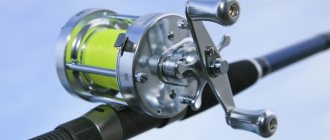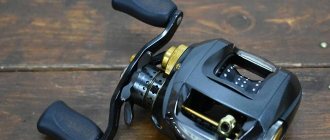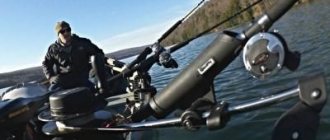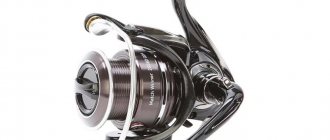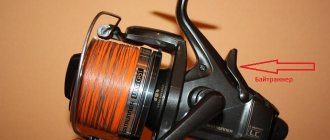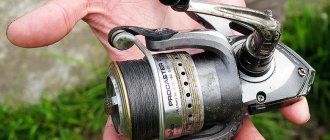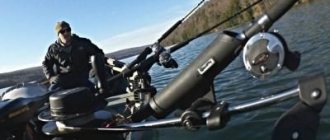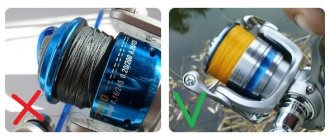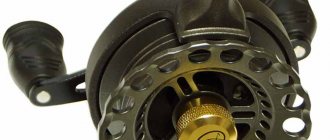The difficulty for a novice fisherman, after choosing a spinning rod, is choosing a reel. And they often act on the principle that the reel is not the main thing, but the main thing is skill and experience. In fact, this is a misconception, since in spinning fishing it plays an important role and should be in harmony with the spinning rod. The huge number of fishing reels that fill the shelves of fishing stores makes choosing a difficult task even for an experienced fisherman. There is nothing to say about newcomers. Unfortunately, sellers can only rarely give practical advice, since they themselves do not have sufficient qualifications. How can you figure out whether the high price of a reel indicates its high class? How do coils differ from each other and how not to make a mistake in choosing? After all, a high price may mean that the model contains new technological solutions that make fishing easier, and that it is made of durable materials, or it may just be the result of the greed of an intermediary company selling reels. How to navigate the presented assortment if you know exactly what kind of fish and where you are going to catch?
Dreamfisher.ru comes to the aid of all those who are planning to purchase a reel, but have not yet decided on the type and parameters of the reel for a particular fishing rod. So let's get started.
Types of fishing reels for fishing rods
Initially, the use of the reel consisted of simply storing a supply of fishing line (so that the fishing line did not get tangled). As time went on, the classic reels were increasingly modified. Modern fishing reels, in addition to their main function of storing fishing line, have a significant impact on casting range, and well-chosen reel models can greatly facilitate the landing of large fish. Today, almost all fishing rods are equipped with reels that differ not only in appearance, but also in technical characteristics.
There are spinning, match, wire, fly and winter reels. They are further divided into three types - inertia-free and inertial with a gear ratio of 1:1, inertial with a reverse gear ratio (multipliers are one of the types of inertial coils). The first type of reel is used for spinning and float fishing rods, inertial reels are mainly used for fly fishing (in Russia and for spinning), and multipliers are used for spinning and sea fishing (in general for catching large fish)
Inertia-free reels are produced in two versions: with an open (open type) and closed (closed type) spool. In recent years, “multipliers” that were original in design (also with some changes in design) have appeared. Fishermen immediately “christened” them with a simple word that accurately conveys the visual perception of these reels - “soap boxes”.
Advantages of a spinning reel and its disadvantages
There are many advantages of an inertia-free reel over a conventional inertial reel. Firstly, with its help you can cast much further, especially light baits. Secondly, the spinning reel allows you to use ultra-light baits (which cannot be cast at all with a regular reel). The winding speed can vary from very slow to very fast. The presence of a friction brake allows you to fine-tune the mechanism, which in turn allows you not to be afraid of the line breaking or the rod breaking. Among the disadvantages of an inertia-free reel, I can name two: the twisting of the line (absent in inertial reels) and the high price (but with multipliers the price is even higher).
Spinning reels
Thanks to their high versatility and quick casting ability, spinning reels have become the most popular among anglers of both entry-level and professional levels. When casting, the line comes off the spinning reel without rotating the spool. The spinning reel almost completely eliminates the possibility of tangling the fishing line and the formation of a “beard.” The body of the spinning reel contains some data that you need to be able to decipher. Firstly, the relationship between the diameter of the line and the amount of line that can be used on a given reel. For example, 0.2-100. This means that a line with a cross section of 0.2mm can be placed in an amount of 100m. Secondly, the relationship between the weight of the cast and its possible distance. The gear ratio of the gearbox must be indicated. If there is the inscription “Long Cast”, then the reel design is designed for ultra-long casting. The inscription “ATS” means that the reel is equipped with a system that reduces line twist - an Anti Twist System.
Inertia coils
They are distinguished by the most affordable price. Inertial reels installed on float or winter fishing rods are designed mainly for storing and extending fishing line on the fishing rod. For spinning fishing from a boat or from a shore overgrown with grass or bushes, large inertial reels (from 100 to 150 mm) are used. In this case, the spinning rod is used as a hook (donkey). Inertia reels can be equipped with either a friction or a dead brake. The blind brake is designed to firmly fix the position of the drum. A friction brake, unlike a dead brake, does not fix the spool with such force. As a result, the spool rotates when the line is pulled strongly. This property of the reel is especially important when fishing with thin rigs. Thus, the line will not break if the tension is strong. Sometimes the inertial reel is equipped with a ratchet or reverse brake. Inertial reels are used for fly fishing, sometimes they are used for spinning fishing.
Forging and stamping equipment
The hydraulic intensifier is not an independent drive; it is used in combination with a pump-accumulator to create an additional pressure stage. They are indispensable in the drive of hydraulic presses, in which the working fluid is ultra-high pressure liquid (> 100 MPa).
where p is the fluid pressure in the low-pressure cylinder; D - outer diameter of the cylinder 2 d - diameter of the plunger 7 (see Fig. 8.12).
called the multiplication coefficient. For hydraulic multipliers, the multiplication coefficient is taken in the range of 2…4. Losses due to friction, overcoming inertial and other forces usually do not exceed 5%.
To perform the reverse stroke of the plunger cylinder 2, return stroke cylinders 3 with plungers 4 are used, mounted on a fixed upper cross member 5, which is connected to the low pressure cylinder 1 through columns 6.
Inertial multiplier reels (“multipliers, multipliers”)
Multipliers are equipped with mechanisms for braking the spool, changing the gear ratio, and sometimes with a line counter and line layer. Particularly powerful multipliers are used when trolling. In a baitcasting reel, the spool rotates both during casting and when reeling in the line. This mechanism of action leads to the fact that the casting energy is transferred to the spool and fishing line, which, if cast incorrectly, leads to spontaneous removal of the fishing line and the formation of a beard. To achieve good results using these reels for long casting of small, lightweight lures, the angler must have good casting skills and a keen feel for the cast. The classic baitcasting reel is equipped with a gear system, which, in each specific case, allows you to select the appropriate gear ratio. The gear ratio is the numerical relationship between the number of turns of the handle and the number of turns of the spool. It is usually indicated on the reel body. Let's say the numbers on the reel are 4.4-1. This means that with one revolution of the reel handle, the spool will make 4.4 revolutions. Thus, the gear ratio of this reel is 4.4. A modern multiplier reel is almost as good as a spinning reel in terms of ease and casting range, and in terms of power and reliability it has no equal. An important element of a multiplier reel is a friction brake, which allows you to avoid tangling of the fishing line when casting. Choose reel models with adjustable friction brake. It must be adjusted for each specific casting weight. Fine adjustment will allow the line to flow smoothly, without twisting around its own axis, when casting. The high strength and power of the multiplier reel allows it to be used for catching large fish. Most often, baitcasting reels are used for spinning and sea fishing. A multiplier reel can be used on almost all gear where reliability, power and quality are needed.
What is a multiplier in a gearbox and its purpose?
In fact, the multiplier (accelerator) is a reverse gearbox, since its gear ratio is less than one. A striking example is a mechanical spinning wheel, in which low speeds of a large-diameter wheel are converted into high speeds of the spinning wheel using a pedal drive. A bicycle works on the same principle (with one revolution of the sprocket, the wheel turns several times through the chain), a separator, and a centrifuge. The car's gearbox is also a multiplier with several gear ratios.
Multipliers use various types of mechanical transmissions with one or more stages:
- gear:
- cylindrical (parallel axes, straight or oblique teeth);
- conical (axes intersect, teeth straight or oblique);
- rack and pinion (the axes intersect);
- screw:
- worm gear (with parallel or crossed shafts),
- hypoid (axes with hypoid displacement);
- from flexible elements:
- belts (round, toothed, V-belts);
- chains (plate, bushing, roller);
- frictional (transmission is carried out due to friction).
There are combined multipliers that combine several different gears.
How to properly wind the fishing line onto the spool of a multiplier?
If the capacity of the spool of your multiplier is approximately 170 meters of fishing line with a diameter of 0.3 mm, then this entire length needs to be wound - that is, you need to buy 2 paired reels of 100 meters each or a large reel with a capacity of up to 200-500 meters, pass the end of the fishing line through a line layer, tie a regular double knot around the spool. Next, you will need an assistant for a few minutes. He must position the spool of fishing line so that it does not twist when winding. There are now many braided cords on the market with unprecedented test results. Can they be used on multipliers? It is not recommended for casting light spinners weighing up to 15 g, and here’s why. Ordinary fishing line is elastic and elastic; due to these qualities, when wound on a spool, its upper layer does not cut into the lower one. Braided cord is soft and inelastic, and will deform when laid. And naturally, you won’t be able to cast long distances with it. For casting spinners weighing 15 g and above, a braided cord is quite suitable. In practice, it has proven itself very well.
What should you pay attention to when choosing a reel?
First, you should decide on your financial capabilities. The fact is that the range of prices for spinning reels is very large. There are reels on the shelves with prices ranging from 250 rubles to several thousand rubles. It is clear that they differ not only in technical characteristics, but also in quality. Thus, it is better to choose a reel that is more expensive, but reliable and of good quality. But cheap reels are also in great demand, otherwise why would they be on the shelves. They can be used for fishing with a float rod for long casting. You shouldn’t go to the other extreme - choose the most expensive reel, especially for a beginner spinning rod. It is enough to start by buying a mid-price reel. I am sure that in most cases the costs will be worth it. It is very convenient for beginning spinning players to use match spinning reels as their first spinning reel. These reels are characterized by the fact that they hold line perfectly and are designed to work with thin lines and have a shallow spool.
It is also worth paying attention to the fact that the reel is suitable for its purpose, is reliable and durable, and is also comfortable. Moreover, the first requirement takes precedence over the second and third: a reel that does not meet its purpose simply ruins all fishing. The choice of reel directly depends on the specific fishing conditions and the intended object of the hunt. After all, for catching a certain type of fish, there are different baits (by type, size and weight. The reel must ensure casting, correct placement of the bait and withstand the resistance of the fish that “landed” on it when playing. As for reliability and convenience, there are still some possibilities here what compromises?
Gear ratio
Shows the ratio of the handle rotation to the number of rotations of the line laying rotor. The more revolutions it makes, the faster the reel. Reels with a lower gear ratio (1:3.2-1:4.6) are used for spinning fishing, when the movement of the bait should be slow and smooth (pike, catfish). Such coils are power coils. Faster reels in these conditions will not allow you to move the bait smoothly, evenly at a slow speed. In addition, they are not designed for large fish. High-speed reels (1:5.2-1:6.2) are used for float fishing rods (quick reeling with an empty bite, etc.). Reels with a medium gear ratio (1:4.6-1:5.2) are the most versatile. They are suitable for spinning fishing when medium and fast retrieval is required.
Friction brake
Nowadays, even inexpensive reels are equipped with a quite suitable clutch, but I still want to say a few words about this. The friction brake is designed to prevent the scaffold from breaking when a jerk exceeds the breaking load of the scaffold. With such a jerk, the spool begins to rotate, releasing the line until the load decreases. The brake location can be either front or rear. The front brake ensures smoother operation of the spool. My advice: if you still want to use the brake, and not constantly fish with it tightly tightened, forget that there are reels with a rear drag. On the vast majority of models it is simply disgusting. But cases are different, and therefore if in the process of landing fish you are used to adjusting the brake, then a reel with a rear brake is better suited. In addition, the rear brake allows you to change the spool faster, while with the front brake, changing the spool takes some time. It is important to adjust the clutch correctly and accurately. It is desirable that when the brake nut is finally tightened, the spool does not brake completely, but continues to release the line. This will prevent deformation of the reel mechanism and its breakage under maximum loads. There are also reels with two stages of friction brake adjustment (labeled “Fightin' Drag”). This system looks like two adjustment wheels (rough - fine), and the “fine” wheel has a trigger for more convenient brake changes. With the “rough” wheel you set the required load, and the “fine” wheel will come in handy when fishing.
What is coil gear ratio
Let's first understand what a reel gear ratio is, what it is, and how this number can affect your fishing.
In modern mechanisms, torque in various components is provided by gear transmission. This is when two gears are interlocked, one of which transmits movement to the other. Thus, one of them is leading (it is turned by the engine or the fisherman through the handle), and the second is driven, since its movement is provided by the first. The rotation speed of both gears may be completely different. Thus, each gear can make its own number of revolutions in the same period of time. This is due to the different number of teeth, on which the rotation speed depends.
Let's look at a small example. If the drive gear contains 60 teeth, and the driven gear only thirty, then while the first one makes one revolution, the second one will spin as many as two times. To find out the gear ratio of such a coil, the value of the teeth of the driving gear is divided by the same number for the driven gear, that is, 60/3 = 2. Thus, the gear ratio in our example is two. So, knowing the meaning of this characteristic of the coil, what properties can we learn about in advance?
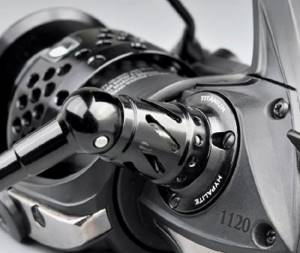
First of all, we note that the internal mechanism of the reel consists of many gears. They can be different in their properties. As soon as the fisherman begins to turn the handle, he starts the movement of the drive gear with a given number of teeth, and it already sets the rest of the mechanisms to work.
You may be interested in: Aluminum boats
It is interesting to note that using the gear ratio it is possible to regulate the torque of the coil. This is achieved by changing the number of teeth in the gear.
So, the resulting rotation is transmitted by the main gear to one or more subsequent ones, which are in mesh with it. The last of these gears (or driven) rotates the line laying rotor. The manufacturer has calculated a strict number of revolutions that it will make in one full movement of the reel handle. To find out the gear ratio of the reel, it is necessary to correlate the number of rotations of the rotor with the revolutions of the handle.
Long casting system (Long Cast, Hyper Cast, Match Spool)
The long-distance casting system is a special elongated spool that allows you to make ultra-long casts and use thin line without thickening the spool. In order to make a long cast of the bait, it is necessary to wind the lines 1-3 mm, not reaching the cheek of the spool. Moreover, the longer the spool, the higher its resistance to slipping.
Zero backlash system
Each reel is designed for a certain load, and if, for example, you get a hook on a braided line and pull the boat to the hook using a spinning rod, you can easily break the reel. The zero-reverse system prevents the line layer from reversing.
Spool
The spool can be metal or plastic. Plastic has one advantage - lightness. With metal spools, the casting range is higher, especially if the front side of the spool is coated with titanium nitrite (a wear-resistant gold-colored coating). The main parameter is the size of the spool. Each reel has a number indicated on it (for example, 2000, 3000, 3500) - this is the size of the spool, and accordingly the reel itself (this parameter is often used to judge the size of the reel, its power, because the larger the spool, the larger the reel, and the more The larger the coil, the more powerful it is and the more severe the conditions for its use). A reel with a spool size of 2500 (according to the Shimano classification) can be considered universal, but it is worth keeping in mind that manufacturers classify their products differently. The size of the coil is usually determined by classification:
“500” is a miniature reel for ultralight spinning.
“1000-1500” is a small reel for ultra- or light spinning rods.
"2000" - medium size.
“3000-4000” is a large traction reel.
“more than 4000” are quite rare reels, truly large.
It is worth paying attention to the length of the spool. It is better to use a reel with a longer spool than a deeper one. This is explained by the fact that when casting on a short (deep) spool, the distance from the edge of the spool side to the winding will sharply increase, which increases the friction of the fishing line (cord) on the side, and, accordingly, the casting range decreases.
Spare spool
A necessary thing if you have 1-2 coils. Allows you to use lines of different thicknesses, for fishing in different conditions and in case your line breaks. It is best to have 3-4 spools with line of different diameters. For example, for fishing with a float rod, spools with lines of 0.1, 0.12, 0.14 and 0.16 are required. Otherwise, if you find yourself in an unusual situation (unexpected approach of a large fish, change of reservoir due to weather conditions, etc.), you will not enjoy fishing.
Other "little things"
When winding onto the spool, the line should lie flat, without bumps or dips; uneven winding can significantly reduce the casting distance. It is good if the reel is equipped with an “endless screw” system or another winding system that ensures even winding of the line at an angle and prevents the upper turns from falling under the lower ones. This winding prevents the upper turns from falling lower. Having an endless screw in the reel is great. But you can live without it because... it is required only for lovers of jerk wiring. There are other kinematic schemes that can ensure good line laying. For example, a crank system with an S-shaped groove lays the line well. Or the use of elliptical and square gears, which provide variable speed of movement of the spool, avoiding its idleness in dead spots.
Choosing a gear ratio for your reel
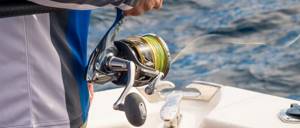
To understand how gear ratio affects fishing, let's look at reels with a minimum and maximum gear ratio. As we have already found out, the smaller the number on the coil, the slower the rotor rotates, and with a large gear ratio of the coil, the correspondingly faster. This means that the reels can be speed or pull (which have slow wiring).
You may be interested in: New for 2021 - Shimano Stella FJ Reel
If you need a reel for catching predators that are fished with a slow retrieve with a smooth movement of the bait, consider reels with a gear ratio of 4.0-4.5. Such reels can be useful when fishing for pike or perch, which often prefer a slow movement of the bait. Reels with a low gear ratio not only have a slow speed, but also have more power, so they are preferable when fishing for large trophy specimens.
By universal reels we mean options in which the gear ratio has average values. The gear ratio of universal coils lies in the range of 4.6-5.2. Such reels are suitable for those fishermen who fish in different conditions with both medium and fast retrieves. This option suits them most.
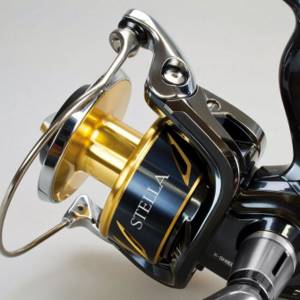
A reel with a gear ratio of 5.3-6.2 will be the best option for high-speed fishing. A high retrieve speed is needed when fishing for asp using surface baits or for catching chub standing under bushes, when the fish takes in the first 2-3 meters of the retrieve or does not take at all. The high-speed reel allows you to quickly reel in the fishing line after an empty bite. When choosing a high-speed reel, you need to take into account the fact that when fishing for large fish, you need to pump out the fish with a rod, and not with a reel. The high-speed reel has less traction capabilities.
Understanding the gear ratio of a fishing reel, an experienced fisherman can choose the best option for himself. It is very important to take a responsible and conscious approach to choosing the gear ratio for your reel, because the comfort of fishing and the size of your catch will depend on it.
